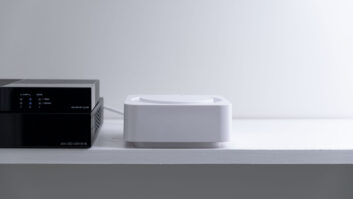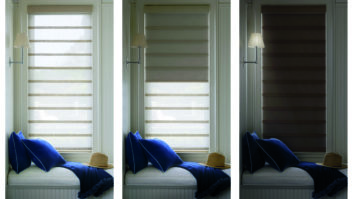There is always vacancy at the Gravesend Inn for the discerning guest. Not far from the M train, the storied establishment sits nestled in the gullet of the conspicuously-named Voorhees Hall. Intrigued by tales of visitation and frightful calamity, I ventured out one dark and dreary evening to meet the keepers of this wonderfully haunted house. John Huntington, professor of entertainment technology at the New York City College of Technology, and his students were my tour guides for the evening. Beginning at the end, we slipped behind the curtain to take a peek at the innards of the Inn before the show began.
To check in, you must descend from the comfortably-lit lobby into the Inn proper. Feelings of trepidation come upon you quickly in the confines of that first web-shrouded stairwell. Initially, ghoulish servants will gently guide you through the Inn’s various amenities, but before long you are left to your own dread as you venture out into the Inn. You may later look back and wonder if those eerie souls perhaps served a more sinister purpose with aims on your sorry hide. Some rooms may be passed by, while some stand between you and a return to a sunlit world. All the while, there is a constant, hunted feeling that you are being watched by an unseen force…
Disclaimer: All exit signs are clearly marked, and the servants are CUNY students who follow a strict no touching and no lunging rule.
Featuring 20 rooms in all, the house operates like a slow moving theme park ride, where guests venture forward only as quickly as their courage allows. “My metaphor is that it’s like a golf course,” Huntington says, “so people merge, and groups play through. We don’t regulate any of that, the audience just does it.” The servants — who turn out to moonlight as CUNY students — guide guests along while hidden sensors cue the effects of each room. An impressive and creative variety of techniques are on display in each room, featuring atmospheric lighting effects, blood-curdling sounds, and even a bit of 4-D kinetic surprise.
At the end of a guest’s journey, they emerge, often still shrieking, into a theater of the damned souls who have already made the passage. Those who had squealed the loudest are sometimes rewarded with a round of applause. From here one can return to the mortal realm, or remain and relive Gravesend Inn over and over again as a mischievous spirit, frightening the tender, new guests with custom pneumatic effects.
The addition to the Inn houses a forlorn animatronic named Oshkilonli. As the first resident spirit to greet you at the Inn, her grim visage is a site to behold. Built by Weigl Controls, and designed by actor and magician Todd Robbins, the Native American spirit laments the loss of her people and land by greedy invaders. For those who fear the uncanny, her countenance is quite unsettling.

Behind the scenes, students from the Entertainment Technology program monitor guests’ progress through an elaborate series of laser trip sensors that hook up to the Medialon master system run. Deep in the bowels of Voorhees Hall, custom-built input boxes Beckhoff input modules receive news of the guests movement and notify Medialon.
“[Medialon] reads all the sensors and then talks to Q-Lab for audio and also talks to lighting next door on a Grand MA console,” Huntington explains.
The Inn began in 1999 as a way to haul some gear off the racks and get the students’ hands dirty. Since then, it has grown and evolved significantly from a purely analog affair to a being run completely on seven VLAN networks, with all audio running through Dante and all video through Alibi CMS and ATEM switchers.
“Everything now is controlled by the network — all the lighting, control data, and the audio is [controlled by the network],” Huntington explains. “All the audio is on Dante, which has worked really well for us. I’m a certified Dante trainer, and [it’s] changed everything for us. It allows you to see problems building up and address them before they become a problem. Distributing around this building would be a nightmare — it was a nightmare, with analog, we did a lot less—Dante allows us to do a lot more with the same resources.”
As an educational experience, the Inn is a fantastic opportunity for students to get hands-on experience with running an entertainment venue. Each student learns a piece of the machine at the Inn, which may be logistical or technical depending on their field of interest. But before anyone gets to lay hands on a control console, he or she must work their way up as an usher. Once they do earn their stripes though, they are given a great deal of autonomy. It is largely up to students coordinate and teach each other the best way to use the systems that control the Inn. Huntington and his colleagues are obviously on hand to help guide them, but there’s little need for hand holding. Instead, the faculty can focus on longer-reaching projects, like designing new features, the timescale of which fall somewhat outside the scope of a full school year.
Before checking out of the Inn, I asked around after folks’ favorite rooms at the Inn. Oshkilonli was a favorite by a wide margin. But when I asked about favorite horror depictions, I was met with a grave silence. “I’m not a big fan of horror actually,” Huntington admits. “The last horror movie I saw was Director’s Cut.”
As I looked over the crowd lining up to check in to Gravesend, I saw a wide range of ages. Kids as young as 10 are encouraged to stop by, but older couples and groups were lined up as well, all nervously clutching each other.
So, who’s next?
To learn more on how Huntington built much of the custom pieces in Gravesend Inn, visit controlgeek.net.







